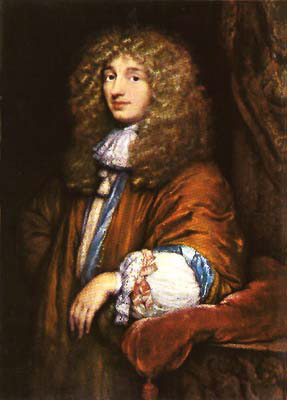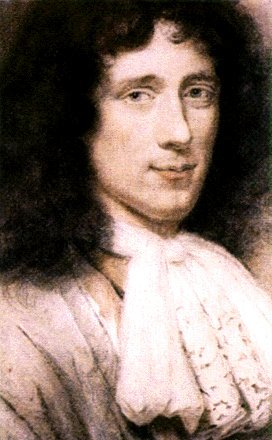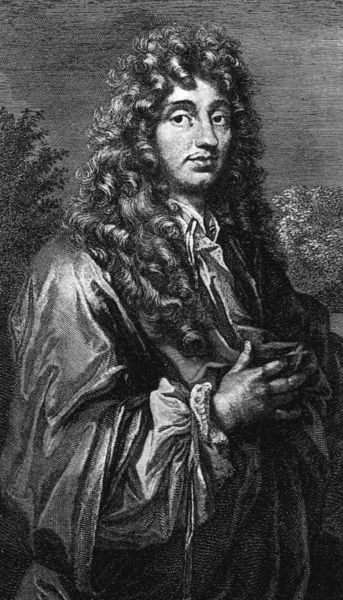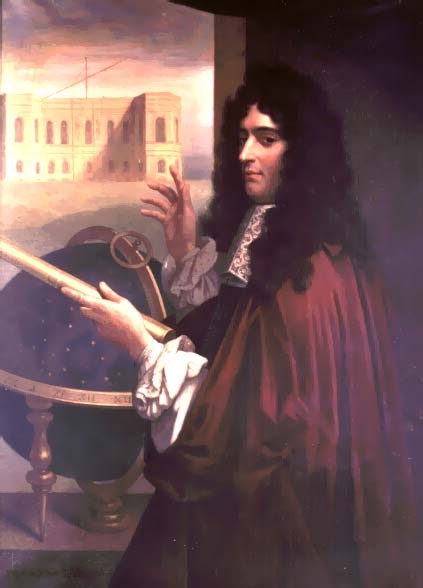<Back to Index>
- Physicist and Astronomer Christiaan Huygens, 1629
- Mathematician and Astronomer Giovanni Domenico Cassini, 1625
PAGE SPONSOR



Christiaan Huygens, FRS (14 April 1629 – 8 July 1695) was a prominent Dutch mathematician, astronomer, physicist and horologist. His work included early telescopic studies elucidating the nature of the rings of Saturn and the discovery of its moon Titan, the invention of the pendulum clock and other investigations in timekeeping, and studies of both optics and the centrifugal force.
Huygens achieved note for his argument that light consists of waves, now known as the Huygens – Fresnel principle, which two centuries later became instrumental in the understanding of wave - particle duality. He generally receives credit for his discovery of the centrifugal force, the laws for collision of bodies, for his role in the development of modern calculus and his original observations on sound perception (repetition pitch). Huygens is seen as the first theoretical physicist as he was the first to use formulae in physics.
Christiaan Huygens was born in April 1629 at The Hague, the second son of Constantijn Huygens (1596 – 1687), a friend of mathematician and philosopher René Descartes, and of Suzanna van Baerle (deceased 1637), whom Constantijn had married on 6 April 1627. Christiaan studied law and mathematics at the University of Leiden and the College of Orange in Breda. After a stint as a diplomat, Huygens turned to science.
The Royal Society elected Huygens a member in 1663. In the year 1666, Huygens moved to Paris where he held a position at the French Academy of Sciences under the patronage of Louis XIV. Using the Paris Observatory (completed in 1672), he made further astronomical observations. In 1678 he introduced Nicolaas Hartsoeker to French scientists such as Nicolas Malebranche and Giovanni Cassini. In 1684, he published "Astroscopia Compendiaria" which presented his new aerial (tubeless) telescope.
Huygens moved back to The Hague in 1681 after suffering serious illness. He attempted to return to France in 1685 but the revocation of the Edict of Nantes precluded this move. Huygens died in The Hague on 8 July 1695, and was buried in Grote Kerk.
After Blaise Pascal encouraged him to do so, Huygens wrote the first book on probability theory, De ratiociniis in ludo aleae ("On Reasoning in Games of Chance"), which he had published in 1657.
Huygens formulated what is now known as the second law of motion of Isaac Newton in a quadratic form. Newton reformulated and generalized that law. In 1659 Huygens derived the now well known formula for the centripetal force, exerted by an object describing a circular motion, for instance on the string to which it is attached, in modern notation:
with m the mass of the object, v the velocity and r the radius. Furthermore, Huygens concluded that Descartes' laws for the elastic collision of two bodies must be wrong and formulated the correct laws.
Huygens is remembered especially for his wave theory of light, which he first communicated in 1678 to France's Royal Academy of Sciences and which he published in 1690 in his Treatise on light (Huygens - Fresnel principle). The later theory of light by Isaac Newton in his Opticks proposed a different explanation for reflection, refraction and interference of light assuming the existence of light particles. The interference experiments of Thomas Young vindicated Huygens' wave theory in 1801, as the results could no longer be explained with light particles (wave - particle duality).
Huygens experimented with double refraction (birefringence) in Icelandic crystal (calcite) and explained it with his wave theory and polarized light. He also investigated the use of lenses as projectors and should be
credited as the earliest inventor, developer and designer of the Magic
Lantern rather than German scholar Athanasius Kircher who merely used much of Huygens research (often quite inaccurately) to document and publish on the subject.
He also designed more accurate clocks than were available at the time, suitable for sea navigation. His invention of the pendulum clock, patented in 1657, was a breakthrough in timekeeping. Huygens is not known ever to have made a clock himself, however; he contracted the construction of his designs to Salomon Coster in The Hague.
In 1673 he published his mathematical analysis of pendulums, Horologium Oscillatorium sive de motu pendulorum, his greatest work on horology. It had been observed by Marin Mersenne and others that pendulums are not quite isochronous, that is, their period depends on their width of swing, wide swings taking longer than narrow swings. Huygens analyzed this problem by finding the shape of the curve down which a mass will slide under the influence of gravity in the same amount of time, regardless of its starting point; the so-called tautochrone problem. By geometrical methods which were an early use of calculus, he showed that this curve is a cycloid, not the circular arc of a pendulum's bob, so pendulums are not isochronous. He also solved the problem posed by Mersenne of how to calculate the period of a pendulum made of an arbitrarily shaped swinging rigid body, discovering the center of oscillation and its reciprocal relationship with the pivot point. In the same work, he analyzed the conical pendulum, consisting of a weight on a cord moving in a circle, using the concept of centrifugal force.
Huygens was the first to derive the formula for the period of an ideal mathematical pendulum (with massless rod or cord), in modern notation:
with T the period, l the length of the pendulum and g the gravitational acceleration.
Huygens also observed that two of his pendulum clocks mounted next to each other on the same support often become synchronized, swinging in opposite directions. He reported the results by letter to the Royal Society of London and it is referred to it as "an odd kind of sympathy" in the Society's minutes. This may be the first published observation of what is now called coupled oscillations.
The oldest known Huygens style pendulum clock is dated 1657 and can be seen at the Museum Boerhaave in Leiden which also shows an important astronomical clock owned and used by Huygens.
Huygens developed a balance spring watch more or less contemporaneously with, though separately from, Robert Hooke,
and controversy over who should be given credit for this important
invention persisted for centuries. This is because Huygens watches
employed a spiral balance spring. However, it should be noted that
Huygens used this form of spring initially only because the balance in
his first watch rotated more than one and a half turns. He later used
spiral springs in more conventional watches, made for him by Thuret in
Paris from around 1675.
Such springs are essential in modern watches with a detached lever escapement because they can be adjusted for isochronism. Based on this fact, many writers in the past and even the present have given Huygens the credit for inventing the modern form of spiral balance spring in 1675 rather than Hooke's earlier straight spring of 1665 because they considered that the spiral form automatically conferred the property of isochronism on the oscillating balance. However, this assumption is incorrect, as all watches in the time of Huygens and Hooke employed the very un-detached verge escapement, the action of which destroys the isochronal properties of any form of balance spring, spiral or otherwise.
In February 2006, a long lost copy of Hooke's handwritten notes from several decades of Royal Society meetings was discovered in a cupboard in Hampshire, and the balance - spring controversy appears, by evidence contained in those notes, to be settled in favor of Hooke's claim.
The
watches which were made in Paris from C.1675 and following Huygens
plan, are notable for lacking a fusee for equalizing the mainspring
torque, showing that Huygens thought that his spiral spring would
isochronize the balance, in the same way that he thought that the
cycloidally shaped suspension curbs on his clocks would isochronize the
pendulum.
In 1673, Huygens carried out experiments with internal combustion. Although he designed a basic form of internal combustion engine, fueled by gunpowder, he never successfully built one. Even though he was unsuccessful with building his internal combustion engine he had given many other scientist the capability to do so.
In 1675, Christiaan Huygens patented a pocket watch. He also invented numerous other devices, including a 31 - tone - to - the - octave keyboard instrument that made use of his discovery of 31 equal temperament.
In 1655, Huygens proposed that Saturn was surrounded by a solid ring, "a thin, flat ring, nowhere touching, and inclined to the ecliptic." Using a 50 power refracting telescope that he designed himself, Huygens also discovered the first of Saturn's moons, Titan. In the same year he observed and sketched the Orion Nebula. His drawing, the first such known of the Orion nebula, was published in Systema Saturnium in 1659. Using his modern telescope he succeeded in subdividing the nebula into different stars. (The brighter interior of the Orion Nebula bears the name of the Huygens Region in his honor.) He also discovered several interstellar nebulae and some double stars.
On 3 May 1661, he observed the planet Mercury transit over the Sun, using the telescope of telescope maker Richard Reeves in London together with astronomer Thomas Streete and Richard Reeves.
Christiaan Huygens believed in existence of extraterrestrial life. Prior to his death in 1695, he completed a book entitled Cosmotheoros in
which he discussed his notions on extraterrestrial life. Huygens was of
the opinion that life on other planets is similar to that on Earth. He
thought that availability of water in liquid form was essential for life
and therefore the properties of water should vary from planet to
planet, since the kind of water that is found on Earth would instantly
freeze on Jupiter and vaporize on Venus. He even reported observing dark
and bright spots on the surface of planet Mars and Jupiter. This he
explained could be justified only by the presence of water and ice on
those planets.

Giovanni Domenico Cassini (June 8, 1625 – September 14, 1712) was an Italian / French mathematician, astronomer, engineer, and astrologer. Cassini, also known as Giandomenico Cassini or Jean - Dominique Cassini, was born in Perinaldo, near Sanremo, at that time in the Republic of Genova.
Cassini was an astronomer at the Panzano Observatory, from 1648 to 1669. He was a professor of astronomy at the University of Bologna and became, in 1671, director of the Paris Observatory. He thoroughly adopted his new country, to the extent that he became interchangeably known as Jean - Dominique Cassini — although that is also the name of his great - grandson, Dominique, comte de Cassini.
Cassini was the first to observe four of Saturn's moons, which he called Sidera Lodoicea, including Iapetus, whose anomalous variations in brightness he correctly ascribed as being due to the presence of dark material on one hemisphere (now called Cassini regio in his honor). In addition he discovered the Cassini Division in the rings of Saturn (1675). He shares with Robert Hooke credit for the discovery of the Great Red Spot on Jupiter (ca. 1665). Around 1690, Cassini was the first to observe differential rotation within Jupiter's atmosphere.
In 1672 he sent his colleague Jean Richer to Cayenne, French Guiana, while he himself stayed in Paris. The two made simultaneous observations of Mars and, by computing the parallax, determined its distance from Earth. This allowed for the first time an estimation of the dimensions of the solar system: since the relative ratios of various sun - planet distances were already known from geometry, only a single absolute interplanetary distance was needed to calculate all of the distances.
Cassini initially held the Earth to be the center of the solar system, though later observations compelled him to accept the model of the solar system proposed by Tycho Brahe, and eventually that of Nicolaus Copernicus. Cassini also rejected Newton's theory of universal gravitation, after an experiment he conducted which wrongly suggested that the Earth was elongated at its poles.
Cassini was also the first to make successful measurements of longitude by the method suggested by Galileo, using eclipses of the satellites of Jupiter as a clock.
Attracted to the heavens in his youth, his first interest was in astrology. While young he read widely on the subject of astrology, and soon was very knowledgeable about it; this extensive knowledge of astrology led to his first appointment as an astronomer. Later in life he focused almost exclusively on astronomy and all but denounced astrology as he became increasingly involved in the Scientific Revolution.
In 1645 the Marquis Cornelio Malvasia, a senator of Bologna with
a great interest in astrology, invited Cassini to Bologna and offered
him a position in the Panzano Observatory, which he was constructing at
that time. Most of their time was spent calculating newer, better, and
more accurate ephemerides for astrological purposes using the rapidly advancing astronomical methods and tools of the day.
In 1669 Cassini moved to France and through a grant from Louis XIV of France helped to set up the Paris Observatory, which opened in 1671; Cassini would remain the director of the observatory for the rest of his career until his death in 1712. In 1673 he became a French citizen. For the remaining forty - one years of his life Cassini served as astronomer / astrologer to Louis XIV ("The Sun King"); serving the expected dual role yet focusing the overwhelming majority of his time on astronomy rather than the astrology he had studied so much in his youth.
During
this time, Cassini's method of determining longitude was used to
measure the size of France accurately for the first time. The country
turned out to be considerably smaller than expected, and the king
quipped that Cassini had taken more of his kingdom from him than he had
won in all his wars. Cassini went blind in 1711.
Cassini was employed by Pope Clement IX in regard to fortifications, river management, and flooding of the Po River. The Pope asked Cassini to take Holy Orders to work with him permanently but Cassini turned him down because he wanted to work on astronomy full time.
In the 1670s, Cassini began work on a project to create a topographic map of France, using Gemma Frisius's technique of triangulation. The project was continued by his son Jacques Cassini and eventually finished by his grandson César - François Cassini de Thury and published as the Carte de Cassini in 1789 or 1793. It was the first topographic map of an entire country.

